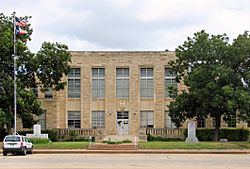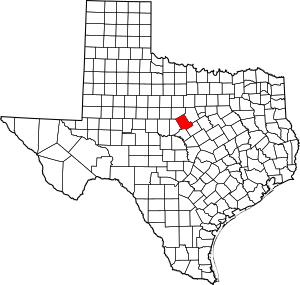Comanche County, Texas facts for kids
Quick facts for kids
Comanche County
|
|
|---|---|

The Comanche County Courthouse in Comanche
|
|

Location within the U.S. state of Texas
|
|
 Texas's location within the U.S. |
|
| Country | |
| State | |
| Founded | 1856 |
| Named for | Comanche tribe |
| Seat | Comanche |
| Largest city | Comanche |
| Area | |
| • Total | 948 sq mi (2,460 km2) |
| • Land | 938 sq mi (2,430 km2) |
| • Water | 9.9 sq mi (26 km2) 1.0% |
| Population
(2020)
|
|
| • Total | 13,594 |
| • Density | 14.340/sq mi (5.5366/km2) |
| Time zone | UTC−6 (Central) |
| • Summer (DST) | UTC−5 (CDT) |
| Congressional district | 11th |
Comanche County is a county located on the Edwards Plateau in Central Texas. As of the 2020 census, its population was 13,594. The county seat is Comanche. The county was founded in 1856 and is named for the Comanche Native American tribe.
Contents
History
- Among the first inhabitants were the Comanche Indian tribe.
- In 1854, Jesse M Mercer and others organized a colony near the future settlement of Newburg in Comanche County on lands earlier granted by Mexico to Stephen F. Austin and Samuel May Williams. Frank M. Collier built the first log house in the county.
- In 1856, the Texas legislature formed Comanche County from Coryell and Bosque counties. Cora community, named after Cora Beeman of Bell County, was designated as the county seat.
- Comanche became the county seat in 1859.
- As of 1860, the county population was 709 persons, including 61 slaves.
- The Comanche Chief began publication in 1873. Editor Joe Hill’s brother, Robert T. Hill, worked on the newspaper while developing his esteemed career as a geologist.
- John Wesley Hardin and his gang celebrated his 21st birthday in 1874 in Brown and Comanche counties. Deputy Charles Webb drew his gun, provoking a gunfight that ended Webb’s life. A lynch mob was formed, but Hardin and his family were put into protective custody. The mob broke into the jail and hanged his brother Joe and two cousins. Hardin fled.
- In 1877, John Wesley Hardin was arrested on a train in Pensacola, Florida by Texas Rangers and a local authority while traveling under the alias James W. Swain. Hardin was tried in Comanche for the murder of Deputy Sheriff Charles Webb, and sentenced to 25 years in Huntsville Prison.
- The Texas Central Railroad began service in Comanche County in 1885, and began carrying cattle and cotton to market.
- By 1890, cotton had become king in the county, but by the start of the 20th century, the boll weevil had devastated the county cotton industry for three decades.
- In 1907, farmers in the county began to experiment with peanut farming.
- Oil was discovered at Desdemona in 1910.
- The peak year for the Comanche County oil boom was 1920. More than 70,000 fruit trees were grown in the county.
- In 1951–1952, a desperate, drought-stricken county experimented with rain making.
- Proctor Lake was impounded in 1963 to provide flood control and drinking water.
- From 1968 to 1974, the Comanche County native Jim Reese served as the mayor of Odessa, Texas. He launched unsuccessful congressional campaigns in the 1976 general election against the Democrat George H. Mahon and in the 1978 Republican primary against George W. Bush.
- During the 1970s, the oil industrialist Bill Noël of Odessa purchased orchards in Comanche County.
- As of 1982, Comanche was ranked second in Texas, with a peanut production of more than 45,546,000 pounds.
The Great Depression
Known for its fertile soil, Comanche County was a hotbed of political populism in the latter years of the 19th century. In the early 20th century, the Comanche region raised hogs, poultry, peanuts, watermelons, cantaloupes, and engaged in dairying. The area normally receives twenty inches of precipitation per year, but in the Dust Bowl of the Great Depression, drought conditions persisted. Farm products lost some 75 percent of their value during the depression, which the area state representative, Oscar Callaway, blamed primarily on the Federal Reserve System. Nearly 200 county families were on public relief, and area churches formed a private community chest for charity. Some sought employment as day laborers. Rabbits raided the peanut crop. Home canning saved many from total ruin. The county sought federal loans for water resources, civic buildings, and parks. At the time, none of the public schools in Comanche County even had a gymnasium. Ben Barnes, a lobbyist who was reared in Comanche County and formerly the former Speaker of the Texas House of Representatives and lieutenant governor, recalled how the Rural Electrification Administration in particular eased the plight of county residents. Despite the hardships, in 1934 all downtown buildings in the county seat were in use, and a few additional businesses opened even as the depression continued. Like much of the rest of the nation, Comanche County nevertheless persevered through the hard times.
Geography
According to the U.S. Census Bureau, the county has a total area of 948 square miles (2,460 km2), of which 938 square miles (2,430 km2) is land and 9.9 square miles (26 km2) (1.0%) is water. The county is located some sixty miles north of the geographic center of Texas.
The county is home to Proctor Lake.
Adjacent counties
- Erath County (northeast)
- Hamilton County (southeast)
- Mills County (south)
- Brown County (southwest)
- Eastland County (northwest)
Demographics
| Historical population | |||
|---|---|---|---|
| Census | Pop. | %± | |
| 1860 | 709 | — | |
| 1870 | 1,001 | 41.2% | |
| 1880 | 8,608 | 759.9% | |
| 1890 | 15,608 | 81.3% | |
| 1900 | 23,009 | 47.4% | |
| 1910 | 27,186 | 18.2% | |
| 1920 | 25,748 | −5.3% | |
| 1930 | 18,430 | −28.4% | |
| 1940 | 19,245 | 4.4% | |
| 1950 | 15,516 | −19.4% | |
| 1960 | 11,865 | −23.5% | |
| 1970 | 11,898 | 0.3% | |
| 1980 | 12,617 | 6.0% | |
| 1990 | 13,381 | 6.1% | |
| 2000 | 14,026 | 4.8% | |
| 2010 | 13,974 | −0.4% | |
| 2020 | 13,594 | −2.7% | |
| U.S. Decennial Census 1850–2010 2010 2020 |
|||
2020 census
| Race / Ethnicity | Pop 2010 | Pop 2020 | % 2010 | % 2020 |
|---|---|---|---|---|
| White alone (NH) | 10,145 | 9,197 | 72.60% | 67.65% |
| Black or African American alone (NH) | 25 | 39 | 0.18% | 0.29% |
| Native American or Alaska Native alone (NH) | 47 | 49 | 0.34% | 0.36% |
| Asian alone (NH) | 34 | 38 | 0.24% | 0.28% |
| Pacific Islander alone (NH) | 4 | 3 | 0.03% | 0.02% |
| Some Other Race alone (NH) | 8 | 24 | 0.06% | 0.18% |
| Mixed Race/Multi-Racial (NH) | 106 | 377 | 0.76% | 2.77% |
| Hispanic or Latino (any race) | 3,605 | 3,867 | 25.80% | 28.45% |
| Total | 13,974 | 13,594 | 100.00% | 100.00% |
Note: the US Census treats Hispanic/Latino as an ethnic category. This table excludes Latinos from the racial categories and assigns them to a separate category. Hispanics/Latinos can be of any race.
Transportation
Major highways
Airport
The Comanche County-City Airport is located two nautical miles (2.3 mi, 3.7 km) northeast of the City of Comanche's central business district.
Communities
Cities
Town
Unincorporated communities
Ghost Towns
- Cora
- Mercer's Gap
- Suez
- Comanche County from the Handbook of Texas Online
 |
Eastland County | Erath County |  |
|
| Brown County | Mills County | Hamilton County |
See also
 In Spanish: Condado de Comanche (Texas) para niños
In Spanish: Condado de Comanche (Texas) para niños

